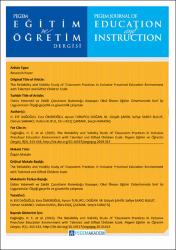The Reliability and Validity Study of 'Classroom Practices in Inclusive Preschool Education Environment with Talented and Gifted Children Scale

View/
xmlui.dri2xhtml.METS-1.0.item-rights
info:eu-repo/semantics/openAccessDate
2019Author
Dagliglu, H. ElifOmeroglu, Esra
Turupcu Dogan, Aysun
Sahin, M. Gulsah
Sarici Bulut, Safiye
Sabanci, Osman
Kukul, Volkan
Kilic Cakmak, Ebru
Karatas, Sercin
Metadata
Show full item recordAbstract
The aim is to develop a scale to demonstrate the instructional approaches that teachers apply in inclusive preschool classrooms, where typically developed and talented/gifted children are educated together. A total of 156 teachers working in inclusive preschools in Ankara formed the study group. The scale consists of 22 five-point, Likert-type items. Both exploratory and confirmatory factor analyses were performed. As a result of the exploratory factor analysis, a structure consisting of three factors and 18 items was obtained. The first factor termed as 'Differentiation' consists of seven items, while the second factor, 'Detection and Development of Potential' consists of eight items, and the third factor of the scale, 'Motivation' consists of three items. The scale accounts for 44.61% of the total variance. As a result of the confirmatory factor analysis, it determined that the scale was in good agreement with the model in general. The Cronbach alpha internal consistency coefficient of the scale is defined as.88 and the reliability of the subscales is determined between.76 and.83. In addition, the correlation coefficients of the items in each factor are higher than.30. In general, it is found that the three-factor structure of the scale is valid and reliable.

















